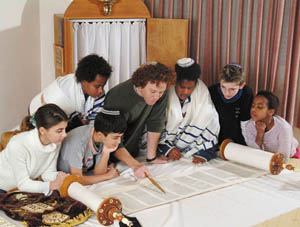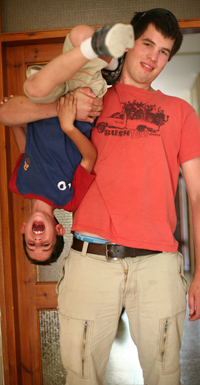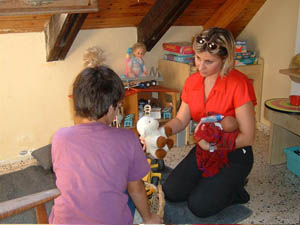 Contact Us
Contact Us
 Contact Us
Contact Us
 Children who live in Neve Hanna and children on our daycare program have lived through traumatic experiences prior to their arrival at Neve Hanna. Many experienced physical and emotional neglect, physical and sexual abuse and economic hardship to the point of extreme poverty and hunger. Neve Hanna is home to these children. We strive to help them overcome past experiences, educate them so they become independent and responsible adults and teach them mutual respect and tolerance. We try to maintain contact between children and their parents. Our social workers are in constant touch with school teachers and when possible, with the families.
Children who live in Neve Hanna and children on our daycare program have lived through traumatic experiences prior to their arrival at Neve Hanna. Many experienced physical and emotional neglect, physical and sexual abuse and economic hardship to the point of extreme poverty and hunger. Neve Hanna is home to these children. We strive to help them overcome past experiences, educate them so they become independent and responsible adults and teach them mutual respect and tolerance. We try to maintain contact between children and their parents. Our social workers are in constant touch with school teachers and when possible, with the families.
Values
We pay great attention to aesthetics, hygiene and work ethics. Children receive pocket money so they can learn how to handle money and how to save it. They work for additional pocket money in the afternoons in the bakery in order to learn the value of money. Furniture, clothes and equipment are all high quality and in very good condition and children learn to value and cherish what they have.
Religion and Heritage
 In accordance with the Conservative Movement that Neve Hanna is affiliated with, children are taught Jewish values. They say their prayers before and after meals, join the Shabbat and holiday services, learn about Jewish heritage and tradition and celebrate their Bar/Bat Mitzvah. A female Rabbi employed at Neve Hanna prepares the children for the Bar/Bat Mitzvah celebration, an important event with many guests who join the children's celebration.
In accordance with the Conservative Movement that Neve Hanna is affiliated with, children are taught Jewish values. They say their prayers before and after meals, join the Shabbat and holiday services, learn about Jewish heritage and tradition and celebrate their Bar/Bat Mitzvah. A female Rabbi employed at Neve Hanna prepares the children for the Bar/Bat Mitzvah celebration, an important event with many guests who join the children's celebration.
 Neve Hanna is very proud of its long tradition of volunteer work. Volunteers from Israel and overseas are active in all types of daily work. Our children's lives would be completely different without the volunteers. Younger and older volunteers come and help on a regular basis, doing their work enthusiastically. Groups of young people often arrive for special missions to complete specific tasks.
Neve Hanna is very proud of its long tradition of volunteer work. Volunteers from Israel and overseas are active in all types of daily work. Our children's lives would be completely different without the volunteers. Younger and older volunteers come and help on a regular basis, doing their work enthusiastically. Groups of young people often arrive for special missions to complete specific tasks.
Volunteers From Abroad, Specifically From Germany
Young volunteers from abroad have been giving assistance at Neve Hanna since its establishment. When Hanni Ullmann worked at "Ahawa" she already believed in the integration of German volunteers as a means of reconciling between the two nations. She was among the first Israelis who encouraged German volunteer work in Israel in the early 1960s.Neve Hanna is also proud of its volunteers from the United States and Switzerland who come to work at the children's home.
More information for volunteers from Germany under: www.nevehanna.de
For general information please contact: antje.naujoks@nevehanna.org
Israeli Volunteers in Community or National Service
In addition to the German volunteers who have established the tradition of volunteer work at Neve Hanna, there are Israeli volunteers who help out regularly. High school graduates who volunteer to spend one year at Neve Hanna do their volunteer community service here before joining the army. On other occasions, young Israelis do their national service here as a substitute for military service. Neve Hanna website was built by community service volunteers. Since 2003, community service volunteers arrive after a two-year training program with LEAD for Israeli leadership.
Assignments
 Volunteers assist with different assignments, especially kitchen work, gardening, laundry, transportation and office work, as well as repair work. Yet their real assignment is to form meaningful relationships with the children. The Israeli as well as overseas volunteers who spend a long period of time at Neve Hanna play an important role as mediators. As young people they can maintain a close relationship with Neve Hanna children and serve as big brothers or sisters. For reasons of confidentiality, they are only exposed to a few essential details in the children's personal stories. The relationships formed are based on equality and empathy and are bias-free. Since this is a time-limited bond, it has another educational and therapeutic advantage: Neve Hanna children and youth learn to confront the fear of abandonment.
Volunteers assist with different assignments, especially kitchen work, gardening, laundry, transportation and office work, as well as repair work. Yet their real assignment is to form meaningful relationships with the children. The Israeli as well as overseas volunteers who spend a long period of time at Neve Hanna play an important role as mediators. As young people they can maintain a close relationship with Neve Hanna children and serve as big brothers or sisters. For reasons of confidentiality, they are only exposed to a few essential details in the children's personal stories. The relationships formed are based on equality and empathy and are bias-free. Since this is a time-limited bond, it has another educational and therapeutic advantage: Neve Hanna children and youth learn to confront the fear of abandonment.
Joint Jewish-Bedouin Theater group
Path to Peace – Joint Jewish-Bedouin daycare center
International understanding emerges from friendships and personal relationships between members of different peoples. In accord with this concept, the Board of Neve Hanna initiated in the early 1990's encounters with the Bedouins in the neighboring city Rahat. At first there were joint social activities for Neve Hanna and Rahat children. The underlying concept was that through play and joint activity a friendship might emerge between children of the same age, regardless of their religion. This friendship familiarizes participants with the life style, language, religion, holidays and customs of the other without politics involved.
Hope for a Better Future – Understanding and Reconciliation
The activities led to a strong and stable bond that was not weakened despite the difficult times we have been through. Experience has taught us that bridges can be built between neighboring populations, despite prejudiced views.
Following the friendships that were created, prejudice gives way to understanding and reconciliation between the peoples, enriching the lives of all people involved. Mutual experiences during encounters give a fresh and different perspective that spreads to the children's parents and teachers as well.
Education
 Due to their personal problems, Neve Hanna children need special professional care. Their scholastic achievements are equally important and so are values, manners and appropriate conduct. Many children suffer from developmental and behavioral problems leading, among others to scholastic difficulties. Children who need extra help with school work get assistance in order to close gaps and ensure that they successfully finish school – the key to their future success in adult life. Additionally, they are offered an enrichment program teaching them basic concepts they have not learned at home.
Due to their personal problems, Neve Hanna children need special professional care. Their scholastic achievements are equally important and so are values, manners and appropriate conduct. Many children suffer from developmental and behavioral problems leading, among others to scholastic difficulties. Children who need extra help with school work get assistance in order to close gaps and ensure that they successfully finish school – the key to their future success in adult life. Additionally, they are offered an enrichment program teaching them basic concepts they have not learned at home.
Occupational Opportunities
The bakery has become an occupational opportunity for both Neve Hanna youth who dropped out of school and for those who graduated from Neve Hanna. The bakery also serves educational purposes. Children learn to be punctual, to work in a clean and organized environment, to assume responsibility and work on a team. They get positive reinforcement, discover hidden talents and capabilities and live through positive experiences based on their personal achievements, all leading to a boosted self image.
Neve Hanna children grow up in a tolerant and pluralistic environment guided by values of acceptance and mutual respect.
Like other Israeli children, Neve Hanna children live in a multicultural society. Nevertheless, a multilingual and multicultural society does not necessarily guarantee tolerance and pluralism. Life in Neve Hanna enables children to internalize the notion of tolerance. Firstly, they live together in home-like units, disregarding their countries of origin. Secondly, they become acquainted with volunteers from abroad and learn about their culture. As a result, they experience in a natural manner understanding and reconciliation between peoples.
Joint programs for Neve Hanna and Rahat Bedouin children also promote understanding and lead to cross-cultural friendships.
Children referred to Neve Hanna by social workers or by court order have medical and therapeutic needs. Since they are considered in need of therapy and rehabilitation, they are offered extensive psychological treatment in addition to enrichment and remedial programs. Although most children arrive at a young age, they have already experienced a lot. Some are even incapable of describing in words what they have been through. Special therapeutic programs are needed in order to diagnose the problems and offer a suitable solution.
Types of Therapies
 We try to provide the children with an individually suited therapy program designed to help each child overcome past issues, learn how to deal with present issues and rehabilitate to ensure smooth assimilation into society in the future.
We try to provide the children with an individually suited therapy program designed to help each child overcome past issues, learn how to deal with present issues and rehabilitate to ensure smooth assimilation into society in the future.
Therapy through free play: the therapist offers the child a variety of games that the child can play with. While playing, the child reflects inner and subconscious emotions and conflicts.
Therapy through the Arts: This type of therapy also offers non-verbal expression of subliminal feelings through painting and sculpting.
Animal-assisted therapy: Children who fear physical contact make friends with a pet. The warmth and contact help the child non-verbally work through past experiences. In parallel, the pet facilitates child-therapist communication.
Horse-back riding therapy: Children learn to control the horse through verbal and non-verbal messages and learn to trust the animal despite their fears.
In addition, Neve Hanna offers a wide range of other therapies such as music, drama and dance therapy.
Theory
Many children who experienced hard experienced in their early years cannot talk about it, since these experiences were fixed in their sub conscious before they were processed. Playing enables them to express their conflicts, without talking about them.
Game Therapy offers various forms of games: Function Games which are meant for relaxation and distracting attention, Design Games are meant to encourage the imagination and the creative powers, Rule Games are meant to create a meeting with norms and Social Games are made to overcome conflicts and acquire social skills. In this manner we can also diagnose the child’s conflicts and assist him in problem solving.
The Healing Potential
The game enables accessibility to the child’s unconscious, since during the game the child externalizes unintentionally his repressed conflicts. Expressing conflicts through games enable the therapist to identify the child’s behavioral distractions and deal with them simultaneously.
The child chooses a game – a figure, a doll, dice, a ball or something else and plays with it while the therapist is present, in a warm and supporting environment, which enables the child to freely express his emotions. The child leads the way and the therapist follows him. The child’s externalized emotions and the skills and difficulties he shows let the therapist know about the origin of the child’s problems and the way to solve them.
This method of therapy should also lead to the reducing tensions, active experiences, self-development and self-awareness, as well as to an ability to solve problems. In addition, game therapy also uses for acquiring knowledge and concepts to develop the thought and expression abilities. At the time he is occupied, the child also goes through a social learning process.
Theory
Art is a very effective expression tool for children who cannot verbally express their problems or describe the experiences they’ve been through. This therapy tool is based upon two basic assumptions: that the creative process enables improvement and relief of the existing symptoms, and on the other hand the artistic creation is a psycho-therapeutic process that deals with the origin of the symptoms.
In art therapy there is no importance to the quality of the artwork. The therapy treats each “artwork” as a basis for the therapy work and does not asses its level of quality. Thus, the children being treated in art therapy need not be with special skills or talent.The Healing Potential
The artistic work enables the children to create a direct means of communication. The work is personal in its nature, and each child works in a creation field he feels more related to. The children choose whether to sculpt, paint, play music and more. The artistic creation opens a window to the souls of children who do not express themselves verbally, and the work with therapeutic tools, as well as contact with paint, clay, fabrics, musical instruments and more are considered therapeutic by themselves.
Art therapy makes the children very relaxed and it is not intimidating or pressuring. In addition, the child learns that he can create something with his or her own hands. It is a positive and healthy experience, which contributes to the understanding and raising his self esteem and image. In addition, his identity is developed and consolidated in time.
Theory
Many children, especially those who suffer from mental disturbances, are naturally and totally connected to animals. Using the animal, the child can “send” messages out of his own world to the therapist.
Animal therapy is based upon a “triangle” of therapeutic communication: the therapist – the animal – the patient. The animal is a mediator, and it enables a bi-directional and meaningful work. During the therapy the “human” qualities of the animal in a manner that can reflect and be parallel to the child’s feelings.
The Healing Potential
The “triangle” between the therapist, the animal and the patient, forms unique situations:
The connection with the animal is based upon non-verbal communication, yet feelings can be expressed.
New and unknown situations are formed in the presence of the animal and these demand an immediate response from the child. The child is required to get closer and trust the animal. Thus, a relation of honesty is formed [first of all with the animal], and although it does not include verbal communication, it encourage a healthy mental development of the child.
Animals do not criticize and do not “pass out grades”. The child develops a relationship with them, without tensions or expectations. Thus, he has a feeling of success which strengthens his self image and assists in other fields of life.